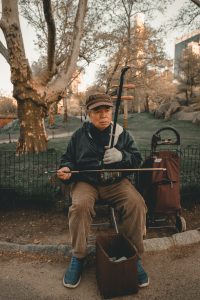In my last blog we touched on the sounds associated with the five elements and Acupuncture. So this week I would like to take a closer look at Chinese music and it’s relationship with healing.
Music is important in all aspects of our existence. We play music at every opportunity, at weddings and funerals, ceremonies of state and sporting events. It also plays a huge role in religious ceremony, whether singing hymns in church, reciting from the Tora or the Koran, singing Sufi devotional songs, or the chanting of Gregorian monks. There isn’t a ceremony or an event that doesn’t involve some sort of music or singing. And as I mentioned in my last blog, it has a role to play in healing.
Chinese Music
In Chinese culture it seems like every thing is done for a reason and nothing is done just for the sake of it. Chinese music is no exception. The five notes of the pentatonic scale in Chinese music coincide with the five elements, and the twelve tones correspond with the months of the year and the hours of the day. Even Confucius had something to say about it. He taught that the five notes of music should blend (like the ingredients of a dish) into a harmonious whole, no one tone dominating over the others, each contributing to the benefit of the group as a whole. So, just like the five elements, balance is the order of the day.

The first note is “jiao” and corresponds to E in Western music. It belongs to the wood element, is the sound of spring, and promotes the smooth functioning of Liver Qi, helping to relieve depression. The second note, “zhi” corresponds to G. It belongs to the fire element, is the sound of summer, and helps to nourish the Heart and invigorate blood flow. The third note is “gong” and corresponds to C. It belongs to the earth element, is the sound of late summer, and strengthens the Spleen. The fourth note is “shang” which corresponds to D and belongs to the metal element. It is the sound of autumn, and protects and nourishes Lung yin. Lastly, the fifth note is “yu”, which corresponds to A. It belongs to the water element, is the sound of winter, and helps to nourish Kidney yin, protect Kidney essence, and reduce Lung fire.
The Six Healing Sounds
In Qi gong (which is itself believed to have originated from shamanic dance) sound is used to purge the major internal organs of noxious and stagnant qi by cooling and cleansing them. There are six sounds (known as liu zi jue) and each is performed with a set of physical movements. Each sound effects an internal organ. Performing these healing sounds can cause yawning, burping, or passing wind. These are all beneficial, so don’t suppress them. Just be careful where you perform them!
1. SSSSSSSSS
The first healing sound is SSSSSSSS (like a snake) which benefits the Lungs. Of all the organs the Lungs are the most in contact with the outer world and all its negative influences, such as germs, viruses and pollutants. Making this sound is good for colds, flu, toothaches, asthma, emphysema, or depression.
2. WOOOOOOO
The second healing sound is WOOOOOO (as if you are blowing out a candle with rounded lips) which is the Kidney sound. Practicing this sound is good for fatigue, dizziness, ringing in the ears, or back pain. It could also be used for issues with reproduction.
3. SHHHHHHHH
The next healing sound is SHHHHHHH, the sound related to the Liver. This sound is used to expel anger, clear the eyes of any irritations, removing a sour or bitter taste, or detoxifying the liver. This sound also controls the quality of blood.
4. HAWWWWWWW
This is followed by HAWWWWWWWW (with mouth wide open), the Heart sound. This sound can be made to alleviate sore throat, cold sores, swollen gums or tongue, jumpiness, moodiness, heart disease and mental disease.
5. WHOOOOOOO
The fifth healing sound is that of the Spleen, WHOOOOOO. This sound can be used to eliminate indigestion, nausea, diarrhoea and worry.
6. HEEEEEEEE
Lastly, there is the sound of the San Jiao (aka the Triple Burner), HEEEEEEE. This organ is unique to Chinese medicine and refers to the three energy centres of the body, or Dan Tien. This healing sound harmonises the temperature between the three centres and the function of the associated organs: the upper section (brain, heart and lungs) is hot; the middle section (liver, kidneys, stomach, pancreas, and spleen) is warm; the lower section (large and small intestines, bladder, and sexual organs) is cool.
These sounds are performed sub vocally, so very quietly, as if on the breath, and just for a few minutes each. In Qi gong it is the intension that is most important, so it is important that the mind is engaged and fully present. Don’t worry about making a loud sound, you just want to feel a vibration in your vocal chords.
Give them a go and see how they make you feel.
The music theme continues next week when I look at how I use sound to make a diagnosis.
If you have any questions about acupuncture, or any of the topics in my blogs, please do contact me. Find out more about me, or my treatments here.

